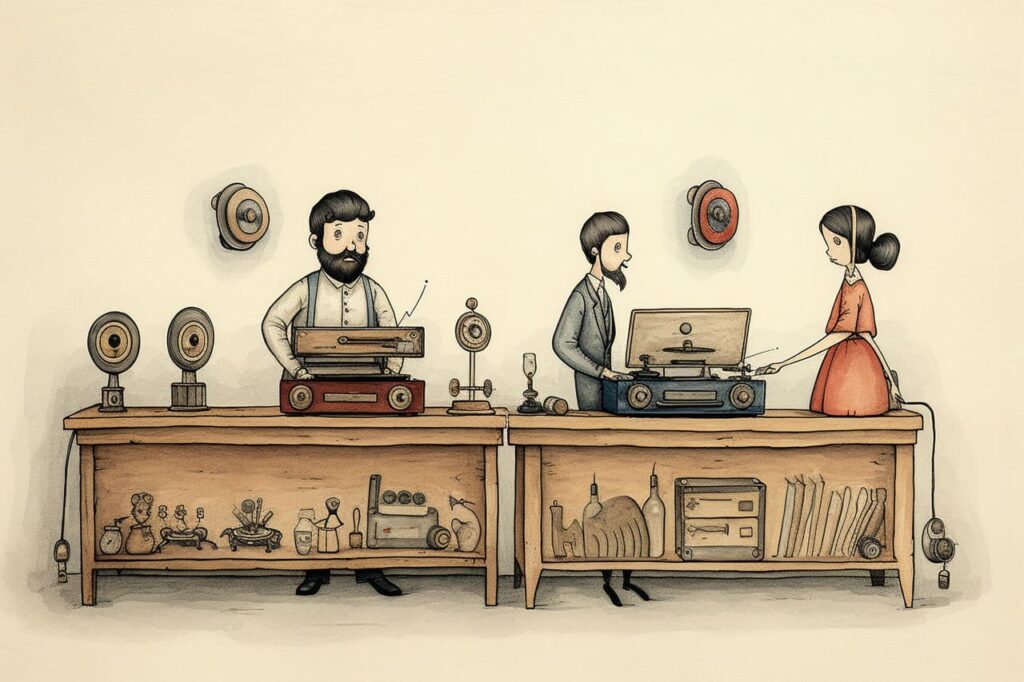Imagine a time traveler from the 19th century—a top-hatted gent, let’s call him Phineas—materializing in today’s world. His eyes would pop at the sight of smartphones and streaming services, but the moment he sees a modern turntable, a knowing smile would play across his lips. “Ah,” he’d say, “the phonograph!” And he wouldn’t be wrong, not really. The record player is the phonograph’s direct descendant, a lineal progression from Thomas Edison’s crank-driven, foil-wrapped cylinder to today’s sleek, digitized, belt-driven marvels that can amplify the heartbeat of a flea.
The Turntable’s Tale: A Revolution at 33 1/3 RPM
Turntables have spun the soundtrack of revolutions, both musical and cultural. It’s the instrument that’s not an instrument, a player in every band without ever learning a note. But oh, the notes it has learned to play. From the crackling voice of Caruso to the soaring symphonies of the Beatles’ “A Day in the Life,” the record player has been the faithful custodian of sound.
A Groove is More Than a Groove
The evolution of the record player is a chronicle of human ingenuity. Each adjustment, from phonograph to gramophone to turntable, was a leap toward immortality for music. A groove in a record is a time capsule, and the needle—a stylus if you’re nasty—is our way of time traveling through sound. The record player’s arm is like the arm of a seance medium, channeling voices from the great beyond, reminding us that those we’ve lost still have something to say.
Spin Me Right Round: A Technological Ballet
The technology has pirouetted from the wind-up mechanics of the gramophone to the laser precision of modern devices. This is not your grandmother’s Victrola, though it owes much to its stately charm. The modern turntable is a masterpiece of precision engineering, capable of finding music in a canyon of vinyl with the delicacy of a surgeon and the sureness of a poet.
The Ritual: Dropping the Needle
There’s a ritual here, one of reverence and anticipation. Dropping the needle on a record is an act of commitment. It’s an analogue for focus in a world drunk on multi-tasking. It’s a declaration that says, “Here, now, this music is everything.” It’s a ritual that insists on participation, a throwback to a time when music wasn’t just background noise but a foreground force.
The Fidelity Fable: Vinyl’s Vengeance
In the narrative of audio fidelity, vinyl has had its vengeance. In the twilight of the 20th century, vinyl was the aging monarch, supposedly dethroned by the shiny, tiny CD. But as the digital age dawned, something unexpected happened. With its warm sound and tactile soul, Vinyl began to claw its way back into our hearts.
The Community of the Turntable
This resurgence isn’t just about sound; it’s about community. Record players have become altars around which the faithful gather, thumbing through bins of records, discussing B-sides and rare imports. It’s a membership card to a club where the music matters and the album art is as important as the grooves it guards.
The Future Spins Forward
Where does the record player go from here? Will it continue to be a beloved anachronism, or will it adapt, chameleon-like, to the changing landscape of music consumption? One thing is for sure—the record player will continue to evolve, to inspire, to be the vehicle through which music asserts its power to move us.
The record player, from its crank-driven infancy to its current laser-etched adolescence, has always been more than a machine. It is the heart of the home stereo, the soul of the DJ booth, the keeper of the flame. It is an invitation to listen, really listen, in a world full of sound but so often devoid of listening. So here’s to the humble record player, the phonograph, the turntable—whatever you choose to call it. Long may it spin.

